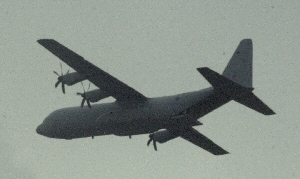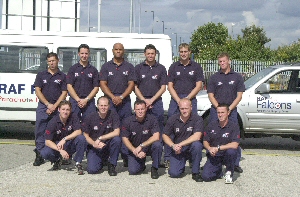- 2003 ON BOARD
WITH THE RAF FALCONS.
-
- Photographs and report by
Patrick Trollope

SATURDAY's
weather was so bad that it was unsafe for RAF Falcon
display team to jump, so they just flew over the top of the crowds
below. This was not the case on Sunday though. Despite
the chance of the weather braking again, a small brake in the cloud
allowed the jumpers to entertain the crowds below and they plunged
out of the Hercules and fell down to land on Southport Beach.
I had the privilege of being up with them as they prepared
for the jump. What people at the show do not realise is
just how hard it is and they do not see the massive amounts of work
that goes on behind
the scenes before the jump. What I did not realise is that
this display team is the only one in the world to use students in a
display, this makes the jumps even more impressive. "The
team are all training to become instructors, so they use these jumps
as part of the training. The members are only in the team for
three years, as they learn. The jumps are also form part of the RAF's recruitment
drive, but we can not say what is the most important part of the
display, when it comes down to recruitment or training."
the team coach told me. I had to ask the jumpers why they did
it "It is just a fantastic feeling to jump. It is a
challenging job and one of the most rewarding." they
all told me.

Before
take off the group take about a hour going over and over what looks
like a dance out side the massive Hercules. This is not really a dance,
but a rehearsal for the free fall, so they can work out the display
that they are going to put on.

|

As the
jump group is planning the moves, inside the crew goes over the
flight plans and check the weather reports with the help of the
ground crews. The crews are based at the drop site and at the
airport. They not only plan the jump, but also do the
recovery. "Everything is checked from cloud
level to wind speed. If the wind is to fast, it is to dangerous for us to
safely parachute, as we might be blown of course or
worse. To cloudy and we could over shoot the landing
area, if we can not see it as we jump out. The conditions have
to be spot on for a good jump and the crew on the ground also have
to make sure the landing site is safe to land." The team coach told me. In all
it took about 4 hours of behind the sense work, but that did not
include the packing of the parachutes and equipment.

When the
green light was given and the aircraft takes off, the jumpers get the kit
on. The crew also get ready for deployment of the jumpers. Then they
do
several passes over the drop zone as final wind speed checks are complicated
and then the call "SMOKES" goes out and the team crack
open the smoke canisters attached on their legs. Out they
go. In side the air crew then close the doors and prepare
for a fly past. Then its all over and back to
base. Then refuel and pick up of the team and off
again. "It keeps you on your toes" one
of the air crew said.

Page 1 of 4
|

